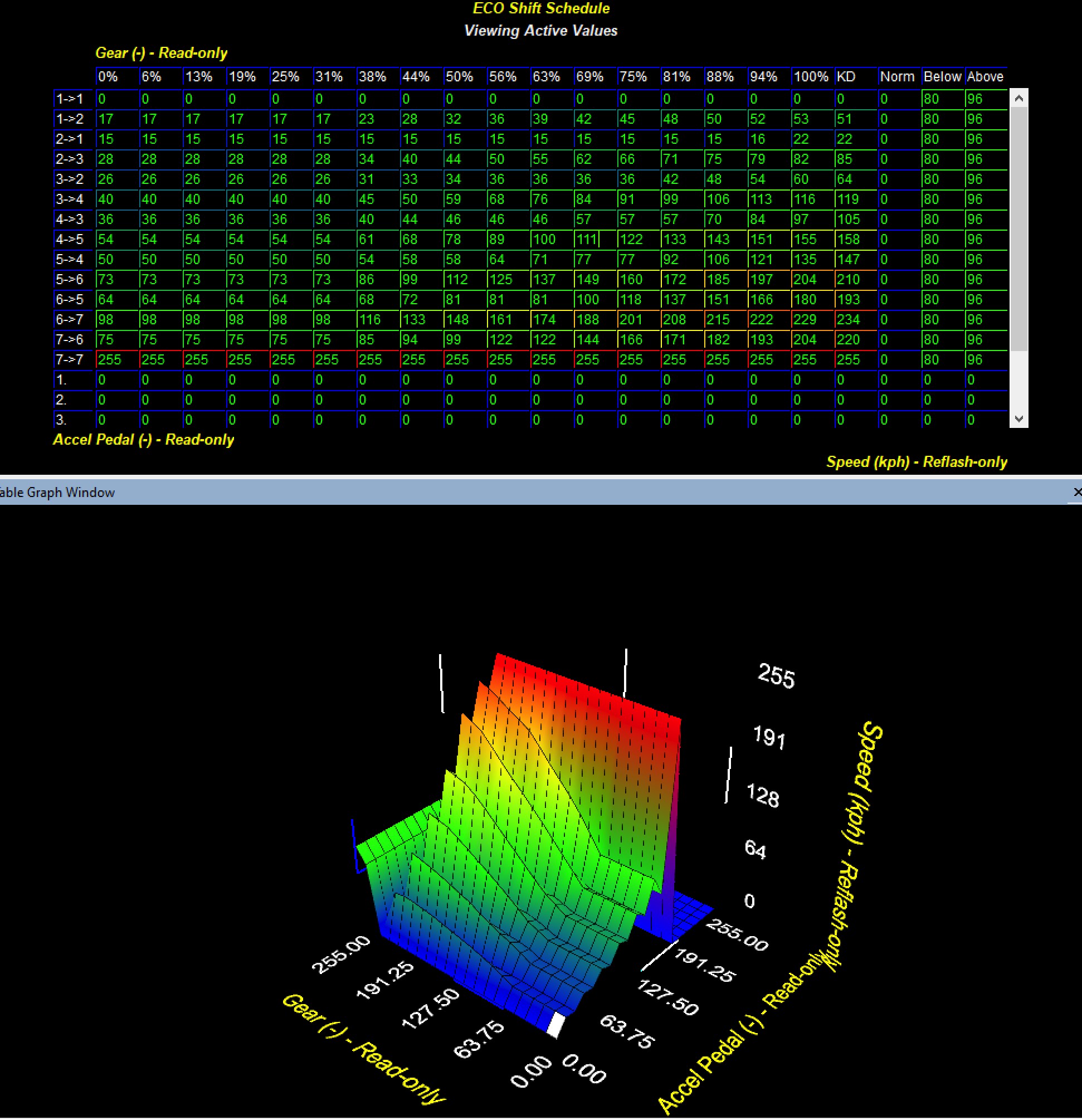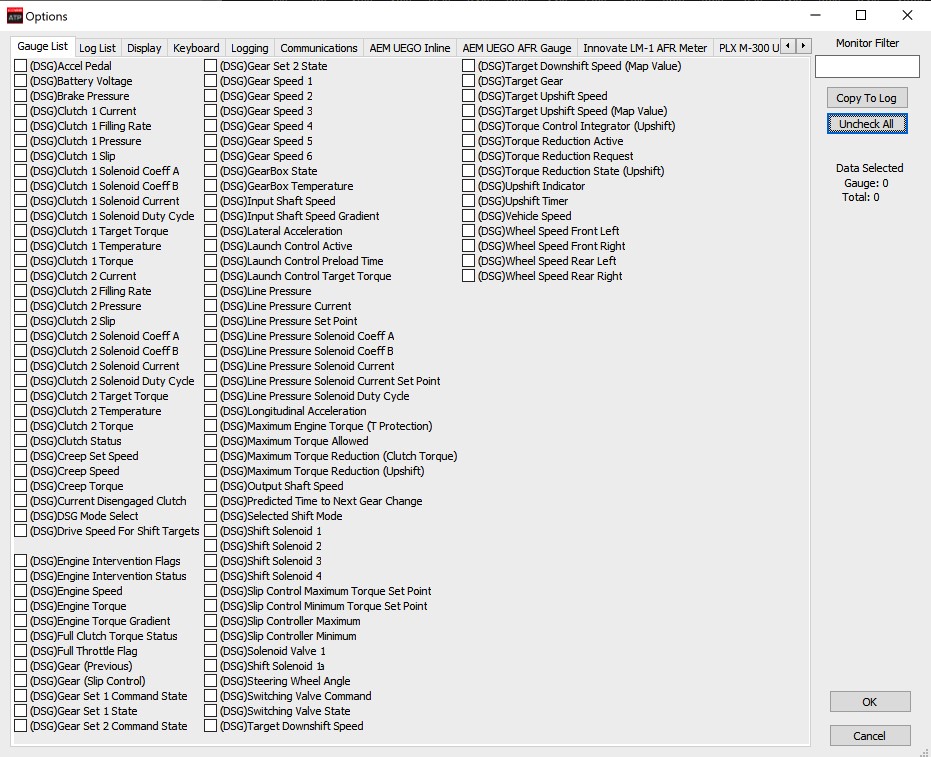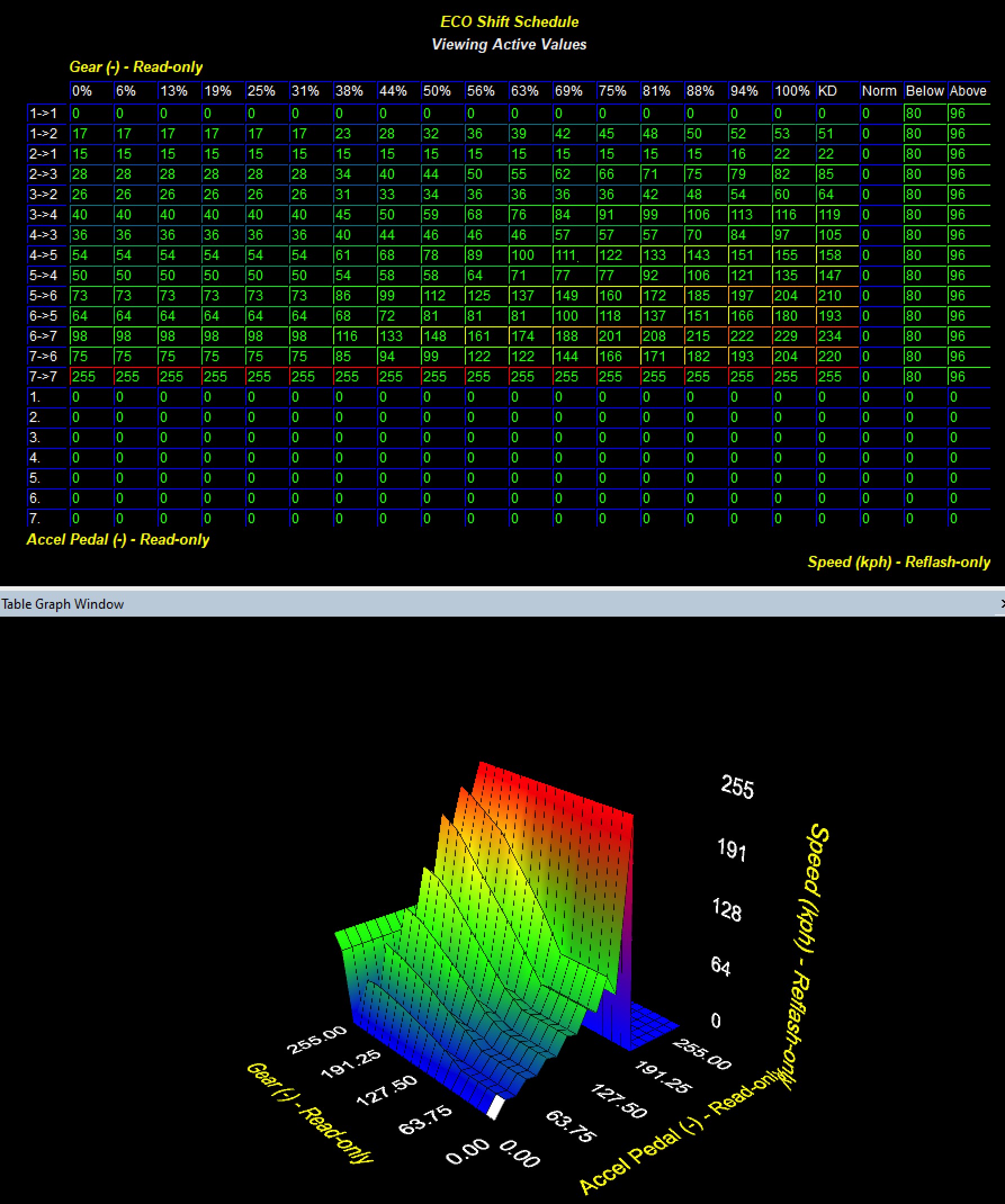Volkswagen MQB 7 Speed DSG Tuning Guide
Improper calibration may cause damage to your vehicle or it's related components.
Table of Contents
Getting to know the MQB 7-Speed DSG
- Basic characteristics: The 7 Speed DSG transmission is similar to the 6 speed in overall design. There are two clutches bathed in transmission oil that are made up of friction disks and clutch plates. One of these clutches manages gears the odd gears and reverse. The other clutch set is responsible for transmitting clamping force to the even gears. The pressures in this wet clutch system are managed via solenoid duty cycle and closed loop clutch pressure targets. 7 speed DSG transmissions are known to hold more torque than the earlier 6 speed cars even in stock form.
- Shift Modes – Similar to the 6 speed DSG transmission the 7 speed versions have a few additional shift modes depending on the tables which are being modified. The main 3 modes are Drive (normal), Sport, and Tiptronic (TT). Depending on the vehicle configuration, there may be additional modes available, such as ECO (Economy), and ALT (High Altitude). Within each of these drive modes there are a few additional tables and logic to further define their function and how the shifting behavior will be.
- Drive and Sport modes Utilize the transmission logic tables in order to choose the correct gear. In these modes the DSG will choose the correct gear based upon
- Throttle position
- Vehicle speed
- Recent driving behavior / timed behavior changes.
- Tiptronic Function (manual shifting) Selected using the factory paddles or by placing the shifter in the manual shifting (Tiptronic) position.
- Drive and Sport modes Utilize the transmission logic tables in order to choose the correct gear. In these modes the DSG will choose the correct gear based upon
- Shift schedule tables This is likely the area that will have the biggest impact on the tune and likely where you'll spend a majority of your time. There is a marked difference in between 6 speed and 7 speed DSG is the configuration of the shift tables. First the 7 speed tables are constructed as a function of throttle position on the x axis and gear change on the y. The z data here is vehicle speed. The organization of the y axis with alternating upshifts and downshifts as seen on the axis labels, makes it very easy to visualize the up and downshift pattern and to recognize when a shift “conflict” in the schedule might occur. In a later section of this guide we’ll go into great detail about how to adjust these tables to produce the desire shift points. Remember, these tables are used only for “automatic” modes (ECO, Normal, and Sport) but are not utilized for any TT (manual) mode.
Commonly Used Acronyms
|
|
What is the Mechanical Configuration of the Vehicle?
The first step in tuning is choosing a COBB Tuning Off-The-Shelf (OTS) calibration that most closely matches the mechanical components and modifications of the transmission to be tuned. COBB OTS maps and tuning guides are meant for stock DSG transmission. COBB does not have specific advice on how to set up DSG transmission with aftermarket clutches.
The features vary across different COBB 7 speed DSG OTS mapping. The following matrix reveals the various features within the COBB OTS mapping. For more information about each map refer to the map notes for the particular vehicle.
- 7 Speed DSG Notes MK7.5 GTI / Audi A3 (8V) / Jetta GLI (A7)
- 7 Speed DSG Notes MK7.5 Golf R / Audi S3 (8V)
| Torque Limit Removed | Gear Display (In All Modes) | Shift Delay (in Manual Mode) | Shift Time Decreased | Kickdown Disabled in TT | Launch Counter Disabled | Low Throttle Shift RPM | |
|---|---|---|---|---|---|---|---|
| Installed Stock | 1100 RPM | ||||||
| COBB OEM+ | X | X | X | X | X | X | 1100 RPM |
| COBB Sport | X | X | X | X | X | X | 1500-2200 RPM |
| COBB Aggressive | X | X | X | X | X | X | 1700-2400 RPM |
Warnings
- If the vehicle being dyno tested is equipped with Active Lane Keep (Assist) it must be disabled as unexpected steering input could result causing a loss of control on the dynamometer.
The Golf R is capable of operating in dyno roll test mode, this deactivates the AWD system and will run in FWD only mode. The Golf R uses the Haldex system, which incorporates an electro-hydraulic clutch to send power to the rear wheels. These clutch type coupling systems can generate excessive heat and wear under heavy load/long time operation on un-linked type chassis dynamometers. As such caution is advised to avoid damage to the transmission
- Current OTS (Engine) maps have Launch Control (LC) enabled in them. The COBB LC system uses rear wheel speed to activate the system. In order to run the car on a 2wd dyno you need to turn the LC Master Switch in AccessTuner to OFF (0). Alternatively you can change the vehicle to traction control Slot 9, which will also completely disable the system.
For more information visit our traction control article here COBB Custom Features: COBB Traction Control on MQB Vehicles
Preparing to Calibrate the Vehicle
Display and Log critical parameters while testing
Accesstuner software allows the user to visualize, sample and record critical engine parameters including sensor information and commanded transmission function.
To setup displayed parameters on the live "Dashboard" press "Ctrl+F" to configure the logged parameters in the "Log List" tab, and those displayed in the Accesstuner "Dashboard" through the "Gauge List" tab. The Dashboard, a screen that reports active transmission and sensor parameters, can be accessed by pressing "Ctrl+B." It is critical to actively monitor the condition of the motor during tuning and this screen is the single best way to do so. These data monitors allow the tuner to determine if a calibration is performing correctly. Accurate and deliberate assessment of logged parameters is the only way to avoid conditions that may damage the transmission.
While connected to a running vehicle press "Ctrl+F" and select the "Log List" tab to select the parameters displayed in saved Accesstuner logs. When data logging is enabled (Ctrl-D) these parameters will be permanently written to a comma delimited data file.
This is a screen shot of some of the available parameters to display in the live dashboard gauges (Gauge List tab) or to be recorded in the data log file (Log List tab). The most up to date list of monitors is always available on the page Engine Monitor List for Volkswagen & Audi MQB Vehicles
Configure recorded (datalog) parameters in the "Log List" tab
Helpful Logging Parameters
The selected parameters are those that are critical to record under most conditions. Other parameters may be selected or removed based upon the objectives of any specific tuning process.
- (DSG)Accel Pedal
- (DSG)Clutch 1 Pressure
- (DSG)Clutch 1 Slip
- (DSG)Clutch 1 Solenoid Duty Cycle
- (DSG)Clutch 2 Pressure
- (DSG)Clutch 2 Slip
- (DSG)Clutch 2 Solenoid Duty Cycle
- (DSG)Engine Intervention Flags
- (DSG)Engine Intervention Status
- (DSG)Engine Intervention Type
- (DSG)Engine Speed
- (DSG)Engine Torque
- (DSG)Gear Box State
- (DSG)Gear Box Temperature
- (DSG)Launch Control Active
- (DSG)Line Pressure
- (DSG)Line Pressure Set Point
- (DSG)Line Pressure Solenoid Duty Cycle
- (DSG)Target Gear
- (DSG)Target Upshift Speed
- (DSG)Torque Reduction Active
- (DSG)Vehicle Speed
Calibration Refinement
- Enable Gear Display Toggle this single value to “0” if you want the gear to be displayed in every drive mode
- Shift Delay Decrease
- Use the Upshift Paddle Delay setting to reduce the delay that happens from paddle activation to shift initiation
- Use the Upshift Paddle Delay setting to reduce the delay that happens from paddle activation to shift initiation
- Target shift Time
- A folder contains many Target Gear Change Time tables. This is the command shift time the transmission tries to achieve. These tables are arranged by drive mode and subdivided by additional factors (altitude, etc). Reduction in the target shift time contributes towards a faster shift time.
- Clutch Overlap
To a point, you can increase clutch overlap in order to allow the transmission to shift faster. This works because if the transmission is able to begin engaging the next (alternate) clutch while the first clutch is still pressurized, the shift can be accomplished in less time. Use tables located in the “Clutch Overlap” folder. These tables are organized by drive mode. Note that in Sport mode the overlap is longer (faster shifts) than in smoother modes such as ECO. COBB OTS maps slightly increase overlap in a subsection of the overlap targets used while in TT mode.
These values can be changed in order to reduce shift times, however going too far can cause catastrophic damage to the transmission.
- Torque Limits
- There are multiple different torque limit tables, several of them will need to be adjusted in order to raise torque limits. An easy way to see which ones is if you were to compare a COBB OTS DSG map to stock.
- These Maximum Torque tables are all raised to between 700 and 800 ft/lbs on the COBB OTS maps
- Maximum Torque (gearbox protection)
- Maximum Torque Clutch 1
- Maximum Torque Clutch 2
- Under Misc tables you will also want to raise
- Target Torque P4 1
- Target Torque P4 2
- These Maximum Torque tables are all raised to between 700 and 800 ft/lbs on the COBB OTS maps
- There are multiple different torque limit tables, several of them will need to be adjusted in order to raise torque limits. An easy way to see which ones is if you were to compare a COBB OTS DSG map to stock.
- Clutch pressures
- In order to be capable of holding more engine torque, you'll likely need to increase the clutch pressures and associated line pressures.
- In the Pressure Target Tables folder several pressure maximums are raised to 21 bar up from a stock value of 15 bar on OTS maps.
- Maximum Allowed Clutch Pressure
- Maximum Clutch pressure for AM
- Maximum Permissible Clutch Pressure
- Maximum Pressure Clutch 1
- Maximum Pressure Clutch 2
- Maximum Clutch Pressure.
- Under Misc tables there are a few additional target line pressure tables that also must be moved up.
- Target Pressure P4 1
- Target Pressure P4 2
- In the Pressure Target Tables folder several pressure maximums are raised to 21 bar up from a stock value of 15 bar on OTS maps.
- In order to be capable of holding more engine torque, you'll likely need to increase the clutch pressures and associated line pressures.
- Stall Speeds
- There are multiple maps that work together in order define what the stall speed should be under different conditions. These tables can be used to significantly impact the transmission behavior and drive quality at low speeds. (i.e. Under what RPM and specific conditions will the clutch be allowed to slip?)
- There are multiple maps that work together in order define what the stall speed should be under different conditions. These tables can be used to significantly impact the transmission behavior and drive quality at low speeds. (i.e. Under what RPM and specific conditions will the clutch be allowed to slip?)
- Adjusting Shift points
- Forced upshift Tables
- These tables are organized by gear and Efficiency mode (EFF) or Accelerator Pedal Position (APP) and are defined by Torque (X axis and the data is engine speed). It uses data the maximum engine speed for each condition. At the bottom of this folder is a single table with a 0 or 1 value that serves to activate or deactivate this entire group of maximum engine speed – Forced upshift tables. They are all left stock in COBB OTS calibrations.
- Kickdown Shift
- In each of the shift schedule tables there is a kickdown data column for each gear and is enabled or disabled with this single data point. 0 = off, 1 = KD on.
- ECO Shift tables
- ECO mode shift tables are utilized for all conditions (automatic mode and TT) in which Sport mode is NOT enabled. In order words, ECO is the Normal drive mode that is enabled. Here we have used effectively ONE table to significantly impact the shift schedule for more sporty performance. These tables are organized by gear shift on the vertical axis and throttle position on the horizontal axis. The Z data is in vehicle speed. “KD” on the x axis is for “kickdown” and this shift point is enabled or disabled with the “kickdown shift” table mentioned above.
The shift schedule looks like a stair step in these tables as the up and downshift schedules are interleaved. This makes seeing the relationship of up and downshift very
easy. Its also easy to see if an upshift and downshift point might collide in an undesirable manner. You can see this relationship a little bit more easily by looking at the table from the side.
- ECO mode shift tables are utilized for all conditions (automatic mode and TT) in which Sport mode is NOT enabled. In order words, ECO is the Normal drive mode that is enabled. Here we have used effectively ONE table to significantly impact the shift schedule for more sporty performance. These tables are organized by gear shift on the vertical axis and throttle position on the horizontal axis. The Z data is in vehicle speed. “KD” on the x axis is for “kickdown” and this shift point is enabled or disabled with the “kickdown shift” table mentioned above.
- Forced upshift Tables
The fact that the Z data is indicated in vehicle speed makes it difficult to easily relate the information within the table, to a real-world result. The best strategy in order to manage more meaningful z data is to convert this table into Engine Speed (rpm). While there isn't a factory table that does so, using available knowledge of gear ratios and some basic math, we can figure it out fairly easily.
In order to display this vehicle speed as engine RPM per gear we must know the conversion. For the 7 speed cars there are TWO different gear ratios. Front wheel drive 2.0-liter GTI and A3 use the following gear ratio/conversion.
GTI, A3
| Row Labels | Average of Ratio |
|---|---|
| 1 | 0.009094651 |
| 2 | 0.013563425 |
| 3 | 0.021456933 |
| 4 | 0.030804481 |
| 5 | 0.039532642 |
| 6 | 0.050773494 |
| 7 | 0.058401822 |
Golf R, S3
| Row Labels | Average of Ratio |
|---|---|
| 1 | 0.005156139 |
| 2 | 0.007985086 |
| 3 | 0.011648665 |
| 4 | 0.015738731 |
| 5 | 0.02075983 |
| 6 | 0.026033506 |
| 7 | 0.033694802 |
Shift Schedule for Each Mode
After a lot of time driving these DSG 7 speed transmissions our impression was that Sport mode was perfect for very spirited driving but that Normal mode shift schedules were not aggressive enough. The car tended to use higher gears to early in the rev range. To create a balanced map we blended ECO (normal) and Sport mapping. These first OTS maps were done as a blend. You can see how this was accomplished on the bottom section of these tuning guide spreadsheets.
The upper section is stock ECO shift schedule. The middle section is sport. The lower section is a blend of eco and sport. In each row the ratio of “sport” to “eco” shift mapping is determined by the red numbers to the left. You can use this spreadsheet to create your own custom blended tables.
Finally, your finished shift schedule can be pasted back into the top of the spreadsheet in KPH to get the data translated into engine RPM.
Related content
Copyright 2025 © COBB Tuning Products LLC. All Rights Reserved. | www.cobbtuning.com







